#palaeobiology
Text
Dinosaurs' range of locomotion made them incredibly adaptable, University of Bristol researchers have found. In a new study, published today in Royal Society Open Science, findings show that the first dinosaurs were simply faster and more dynamic than their competitors, and it's why they were able to dominate the Earth for 160 million years.
The researchers compared the limb proportions of a broad array of reptiles from the Triassic, the period of time from 252 to 201 million years ago, when dinosaurs first appeared and rose to prominence. They identified which of these ancient beasts was quadrupedal (four-footed) or bipedal (two-footed), and also looked at their cursoriality index, a measure of their running ability.
Continue Reading.
65 notes
·
View notes
Text
Massive Winged Dragons
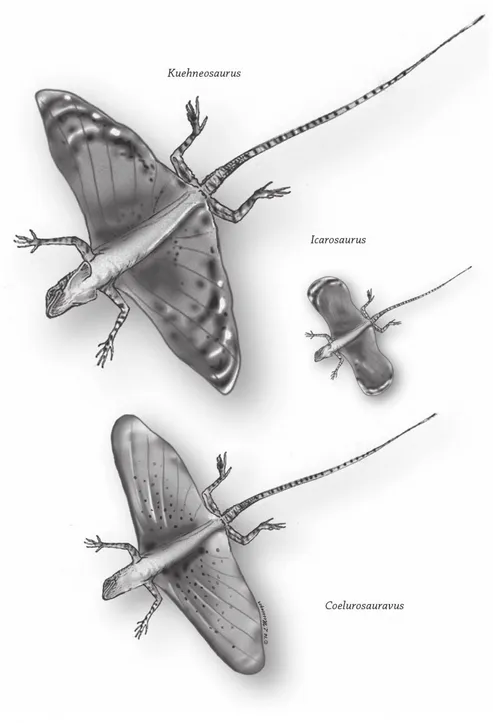
Diagram by David E. Alexander, showing various species of Permian-Triassic gliding reptiles. Compare these wings to the modest wings of modern Draco lizards.
Folks familiar with paleontology might have heard of the kuenheosaurids and weigeltisaurids, two lineages of extinct gliding reptiles superficially similar to modern Draco lizards. The former were apparently stem-lepidosaurs distantly related to modern squamates and tuataras, while the latter are a much older clade with no living relatives. Both groups have wings supported by rib processes, but whereas kuenheosaurids have typical rib-wings like their modern gliding lizard analogues those of weigeltisaurids are actually elements seperate from the ribs proper, allowing them to both have functional ribcages and rib wings!
Though the exact positioning of these elements is still unclear.

Two diagrams of Coelurosauravus, the first with the wing support elements aligned along the ribs and the latter radiating from the armpits.
As you can see, the wings of these animals tend to be proportionally very large for gliders, as well as proportionally elongated. Those of modern Draco lizards are much smaller and rounder, though those of the extinct lizard Xianlong are almost as large(Li 2007). Furtheremore, kuenheosaurids at least co-existed with another rib-glider, Mecistotrachelos, which had wing proportions more similar to those of modern Draco lizards in contrast with the proportionally massive wings for the former (Fraser 2007).
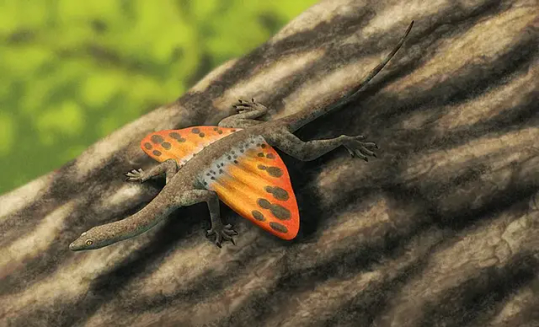
Mecistotrachelos by Cerri Thomas, displaying wing proportions similar to those of modern Draco lizards.
Unlike volaticotheres and non-avian theropods, I’m not going to argue that these were powered flyers, since even weigeltisaurids lack a sternum to which downtroke muscles would be attached (unless they had them attached to the back, like a reverse neornithine condition?).
However, I do think that this hints at far more aerial habits than modern Draco lizards, perhaps relying on thermals or other air currents to soar for long distances. Notably, several kuenheosaurids have different wing shapes (see diagram above), having radiated much as flying birds long after them.
The era of these large winged flyers also coincidentally ends with the arrival of pterosaurs to the scene, with only Xianglong approaching similar wing proportions. Perhaps these gliders occupied niches latter taken by true flying vertebrates, which to me suggests that they weren’t functionally analogous to modern gliding vertebrates.
Food for thought.
References
Pi-Peng Li; Ke-Qin Gao; Lian-Hai Hou & Xing Xu (2007). “A gliding lizard from the Early Cretaceous of China” (pdf). Proceedings of the National Academy of Sciences of the United States of America. 104 (13): 5507–5509. doi:10.1073/pnas.0609552104. PMC 1838464. PMID 17376871.
Fraser, N.C.; Olsen, P.E.; Dooley, A.C. Jr.; Ryan, T.R. (2007). “A new gliding tetrapod (Diapsida: ?Archosauromorpha) from the Upper Triassic (Carnian) of Virginia” (PDF). Journal of Vertebrate Paleontology. 27 (2): 261–265. doi:10.1671/0272–4634(2007)27[261:ANGTDA]2.0.CO;2. ISSN 0272–4634.
5 notes
·
View notes
Text

Do y’all know about these guys??
They’re called Opabinia Regalis and they lived during the Cambrian period
#opabinia#cambrian period#Cambrian#Opabinia Regalis#creatures#upload#artists render#render#fossil#palaeontology#eclipsazoology#palaeobiology#cephalopod#cephalopods#marine creatures#marine biology#biology#marine animals#sea life#aquatic animals#aquatic creatures#ocean life#ocean animals#ocean creatures#aquatic life#sea creatures#sea critters#sea animals#nature#water
34 notes
·
View notes
Text
Welcome to the Palaeo-media Archive!
Hello! This is a new and ever-expanding blog that aims to archive and catalogue every piece of media that features ancient beasts and terrible lizards. Below are a few FAQs, but feel free to send an ask or email (palaeomediaarchive@ hotmail.com) with further questions.
WHAT EXACTLY WILL BE CONSIDERED?
In order for a movie/show/book etc. to be considered, they must contain either in part (hybrids/mutations/fossils), or fully, a prehistoric creature. They must also feature heavily to be included - a three second shot of a dinosaur in the background does not count.
At present, media that contains mythological creatures/cryptids inspired by prehistoric creatures will not be considered. For example, anything that features lake monsters/the loch ness monster or media such as Godzilla will not feature, even if they are heavily inspired by and referenced as a dinosaur-like beings.
WHAT MEDIA WILL BE FEATURED?
Anything and everything! Movies, documentaries, novels, video games, shows, anime, cartoons, comics etc. If there's an ancient creature there, it'll count.
Some media may come under a Mature rating, any that do will be tagged as such.
WHO RUNS THE BLOG?
The Palaeo-media Archive was created in August 2023 by Taryn Freeman, a recent Geology & Palaeobiology graduate with a great enthusiasm for palaeomedia in all forms. You can find her on Twitter under jurassicbcrk or on Bluesky Social under actualraptor
3 notes
·
View notes
Text

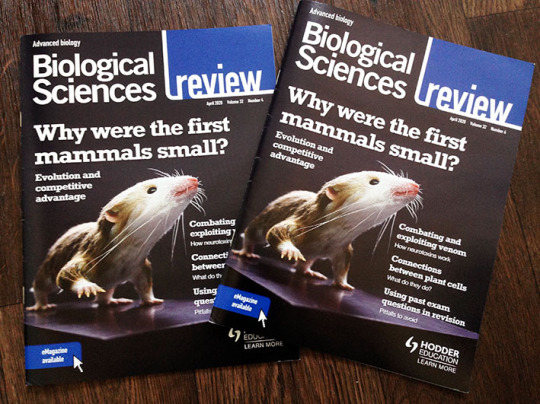
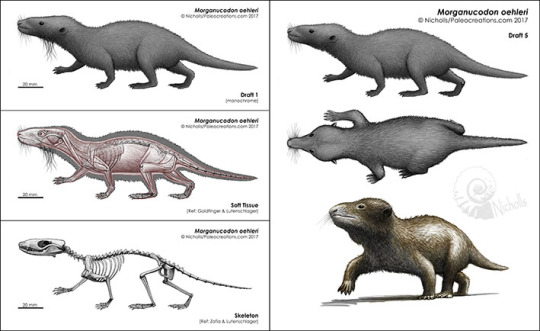

Today's random portfolio artwork post is my model of Morganucodon, an early mammaliaform from the Late Triassic and Early Jurassic. Created for the University of Bristol Palaeobiology Research Group and the National Museums Wales.
#Art#Painting#PaleoArt#PalaeoArt#SciArt#SciCom#DigitalArt#Illustration#Dinosaurs#Birds#Reptiles#Palaeontology#Paleontology
204 notes
·
View notes
Text


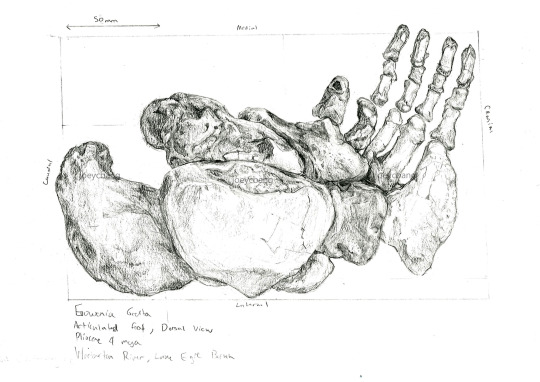


I took a four week intensive on Scientific Illustration over the summer, and these are what I consider my best work. It was a very interesting experience and I don't think I've learned so much in that short of a period before.
Specimens:
Thylacine Thylacinus cynocephalus: Copy of WAM 13.2.16
Red Kangaroo Osphranter rufus: FUR 272
Euowenia grata: FU 2671
References:
Camens, A. and Wells, R. (2009) ‘Diprotodontid footprints from the Pliocene of Central Australia’, Journal of Vertebrate Paleontology, 29(3), pp. 863–869. Available at: https://doi.org/10.1671/039.029.0316.
Camens, A.B. and Wells, R.T. (2010) ‘Palaeobiology of Euowenia grata (Marsupialia: Diprotodontinae) and its Presence in Northern South Australia’, Journal of Mammalian Evolution, 17(1), pp. 3–19. Available at: https://doi.org/10.1007/s10914-009-9121-2.
#joeycbang art#scientific illustration#paleoblr#paleoart#orthographic projection#extinct species#extant species#thylacinus cynocephalus#thylacine#osphranter rufus#red kangaroo#euowenia grata#diprotodontidae#diprodontia#marsupials#megafauna#australian megafauna#australian fauna#id in alt text#so yea this is why i haven't had any art for my main in a bit. i've been a busy boy#yes i made ANOTHER blog for this i'm blogs georg
56 notes
·
View notes
Text
Fossil Novembirb 3: Race to the Sea
Among the rapidly diverging groups of dinosaurs right after the end-Cretaceous extinction were quite a few groups that went "hey, the ocean... it's full of food... let's go there"
And the ways they went there? Multifaceted and Fascinating
Today, we know of plenty of different types of marine birds, around the world. But in the Paleocene, the hotspot of marine bird evolution was Aotearoa, aka Zealandia.
Here, many early marine birds evolved, stretching out their wings in one way or another to grab the nearest available food sources. One common way modern birds live on the sea is by soaring - rarely touching ground, living their lives over the water, looking for food.
And this mode of life appears to have evolved early, with the first tropicbirds evolving right out the gate with Clymenoptilon. And it wasn't alone among flighted marine birds! Protodontopteryx, the first pseudotoothed bird, is also known from the Paleocene of Aotearoa.

Protodontopteryx by @otussketching
Pseudotoothed birds are one of the most common clades of fossil bird, having thrived in marine habitats across the world until the start of the Pleistocene. Like all modern birds, they weren't able to just re-develop teeth, as the gene for enamel had been lost. However, they - like many other birds that eat on slippery or finnicky prey - worked around that by evolving fake "teeth", or projections, on the parts of their body they did still have.
Most living birds evolve such things as lamellae, aka, little pointy bits on their tongues.
Pseudotoothed birds did so by evolving jagged edges out of their jaws.
And the early Paleocene is where that all started!
That said, Protodontopteryx does not seem suited to soaring flight, and probably lived most similarly to living albatross, selecting targeted prey and sticking close to the shore - the start of a long love affair with the ocean for the clade.
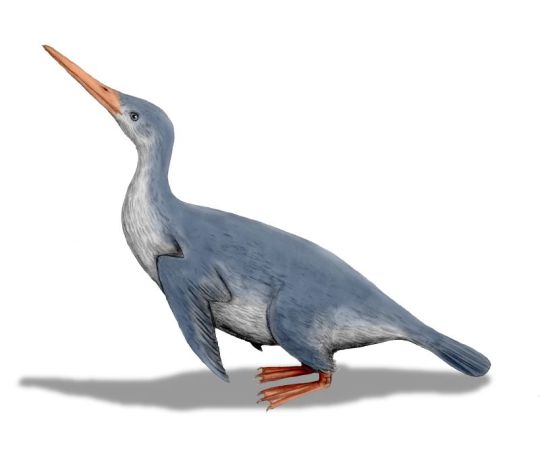
Waimanu by Nobu Tamura
Of course, the reason we're all here is penguins. Penguins are some of the most charismatic birds today, even dubbed the "pinnacle of dinosaurian evolution" by one Dr. Thomas Holtz. And they appeared right away in the Paleocene, showing up just after the impact event - and showcasing a dramatically rapid evolution towards fully marine life.
Early penguins were weird transitional birds, a cross between a normal Neoavian and their later shape, which looks remarkably like living loons and divers. The first penguins we have, Waimanu and Kupoupou, were very similar to modern penguins - so we don't exactly know how this transition started, or when penguins eventually lost flight. Muriwaimanu, however, did show a different form of swimming through the water, indicating that modern penguins developed it later.
Though, they fly through the water, so it's not like they lost it for nothing!

Kumimanu by Nobu Tamura
The ocean, though depleted from the asteroid impact, recovered faster than the land, and was filled with a variety of food items that these different kinds of birds could feed on. Molluscs, Crustaceans, worms, and fish were all available, allowing Aotearoa to host a diverse flock of marine birds, and for penguins to diversify rapidly.
Because, quickly after the evolution of the first penguins, we start to see more and more - and they were huge. Kumimanu was much bigger than living penguins, and Sequiwaimanu had legs similar to other large penguins found in the region.
This was just the start of the Golden Age of Penguins, and we'll revisit them later. We have some other giant birds to meet first...
Sources:
Blokland, J. C., C. M. Reid, T. H. Worthy, A. J. D. Tennyson, J. A. Clarke, R. P. Scofield. 2019. Chatham Island Paleocene fossils provide insight into the palaeobiology, evolution, and diversity of early penguins (Aves, Sphenisciformes). Palaeontologia Electronica 22 (3): 22.3.78.
Mayr, 2022. Paleogene Fossil Birds, 2nd Edition. Springer Cham.
Mayr, G., V. De Pietri, L. Love, A. A. Mannering, R. P. Scofield. 2019. Oldest, smallest, and phylogenetically most basal pelagornithid, from the early Paleocene of New Zealand, sheds light on the evolutionary history of the largest flying birds.
Mayr, 2017. Avian Evolution: The Fossil Record of Birds and its Paleobiological Significance (TOPA Topics in Paleobiology). Wiley Blackwell.
67 notes
·
View notes
Text
A new pterosaur specimen from the Lower Cretaceous Yixian Formation of Liaoning Province, China: The oldest fossil record of Nurhachius
Published 28th June 2023
A new fossil specimen of the Istiodactylidae Nurhachius from the Liaoning Province.
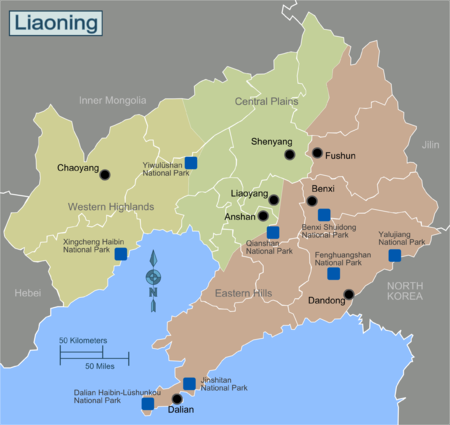
Image of the Liaoning Province, from Wikitravel.

Nurhachius ignaciobritoi described 6th October 2005.

Nurhachius luei holotype (BPMC-0204), described 19th September 2019.
Nurhachius is an almost mature pterosaur with an estimated wingspan of 1.6 m and is geologically the oldest known occurrence of Nurhachius. The istiodactylidae is a new component of the pterosaur assemblage of the Jingangshan Member, and provides new information on the pelvis and hindlimb of istiodactylids and the palaeobiology of this clade. A great discovery that provides more information for the pterosaurs in China.
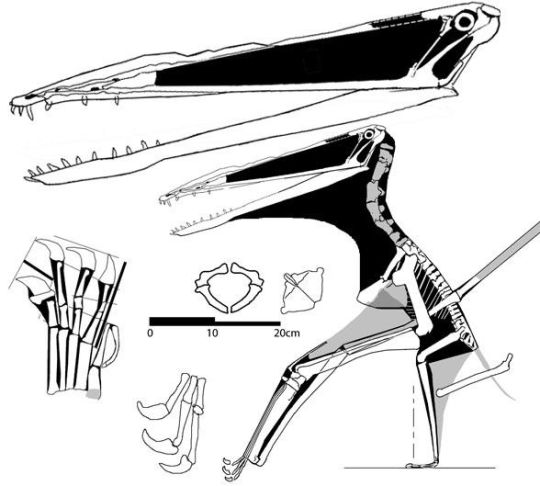
Skeletal reconstruction of Nurhachius, from:
note that this reconstruction may not be reliable or accurate and may be a speculative/innovative creative vision of Nurhachius' appearance (note added in response to feedback, thank you! I'll make sure to include disclaimers/warnings in the future for less trustworthy sources)
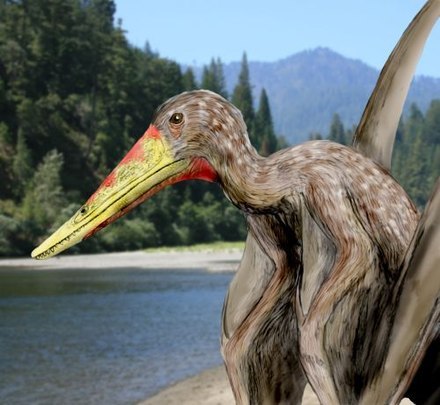
Paleo art of Nurhachius, on Wikipedia.
Source:
read the paper for more information.
36 notes
·
View notes
Text
Archaeology and ecology combined sketch a fuller picture of past human-nature relationships
https://sciencespies.com/environment/archaeology-and-ecology-combined-sketch-a-fuller-picture-of-past-human-nature-relationships/
Archaeology and ecology combined sketch a fuller picture of past human-nature relationships
For decades now, archaeologists wielded the tools of their trade to unearth clues about past peoples, while ecologists have sought to understand current ecosystems. But these well-established scientific disciplines tend to neglect the important question of how humans and nature interacted and shaped each other across different places and through time. An emerging field called archaeoecology can fill that knowledge gap and offer insights into how to solve today’s sustainability challenges, but first, it must be clearly defined. A new paper by Santa Fe Institute Complexity Fellow Stefani Crabtree and Jennifer Dunne, SFI’s Vice President for Science, lays out the first comprehensive definition of archaeoecology and calls for more research in this nascent but important field.
While an archaeology or palaeobiology study might examine a particular relationship, such as how humans in New Guinea raised cassowaries during the Late Pleistocene, archaeoecology takes a much broader view. “It’s about understanding the whole ecological context, rather than focusing on one or two species,” Dunne explains.
Crabtree hatched the idea for the paper in March 2020 after isolating in her father’s basement in Oregon as COVID spread across the U.S. She and Dunne, who had both worked on projects about the roles of humans in ancient food webs, realized that work didn’t fit readily in either archaeology or ecology. At the time, there was no notion in the scientific community of an area of research that deeply integrated those two disciplines. Crabtree, an archaeologist, and Dunne, an ecologist, saw an opportunity to define archaeoecology, including the role it can play in addressing the myriad challenges of the Anthropocene.
Archaeoecology, they explain in the paper, examines the past ~60,000 years of interplay between humans and ecosystems. It aims to show not only how humans impact nature, but also how the ecosystems they lived within shaped human culture and dynamics. To achieve this, archaeoecology weaves together data, questions, strategies, and modeling tools from archaeology, ecology, and palaeoecology.
“What it’s doing is breaking down a traditional, but unnecessary, disciplinary separation between archaeology and ecology,” Dunne says.
Crabtree hopes the paper will encourage more scientists to pursue research in the emerging field. And with humanity facing the twin crises of climate change and biodiversity loss, archaeoecology could yield crucial insights that help us navigate our present-day environmental challenges, she says. For instance, as climate change causes Utah’s Great Salt Lake to dry up, we don’t know exactly how this will impact the larger ecosystem. However, we can look to the past for warnings about what might be in store: Through an archaeoecological lens of the Aral Sea during the height of the Silk Road, we can see more clearly how the Soviet Union’s 1960s water diversion project and the subsequent desiccation of the sea impacted the surrounding ecosystems and human communities. Similarly, an archaeological lens documents the stabilizing role that Martu Aboriginal people had on Australia’s Western Desert and the massive biodiversity loss that resulted when the people were removed from the land.
“Every ecosystem on the planet is impacted by humans in one way or another,” Crabtree says. “It’s naïve to look at just the last 100 years because people have been impacting ecosystems everywhere for many thousands of years. We need to understand the past to understand our present and future. Archaeoecology helps with that. We can learn from these experiments with sustainability in the past.”
Story Source:
Materials provided by Santa Fe Institute. Note: Content may be edited for style and length.
#Environment
#2022 Science News#9-2022 Science News#acts of science#Earth Environment#earth science#Environment and Nature#everyday items#Nature Science#New#News Science Spies#Our Nature#planetary science#production line#sci_evergreen1#Science#Science Channel#science documentary#Science News#Science Spies#Science Spies News#September 2022 Science News#Space Physics & Nature#Space Science#Environment
5 notes
·
View notes
Text
My Degree
I just finished by masters degree in Earth Sciences. Whilst I struggled with studying and powering through my adhd, I really love this subject, and don't regret a thing. In my final year I ended up focusing on oceanography and palaeobiology, but truly I could have gone down the geology route and have been just as passionate.
There are many things I could have studied and have been just as passionate. For a while I thought it just had to be science, that I wasn't made for humanities, but I don't think that is true as much now. I've always loved art - I was pretty good in school, at most forms of it, but ended up especially liking physical art. I guess that's why I crochet and knit mostly now, but I would do pottery if I could afford that hobby. I've got out the practice of drawing and painting, but might pick it up again now.
I love reading - admittedly I don't do it that much, and have been using the excuse of my uni work for the past 4 years, but whenever I do read a book I love I think to myself how I perhaps would have loved to do a literature degree. Essays were actually the thing I usually ended up performing better in, as much as I whinged.
History, too. I learn for fun, and like writing essays. Perhaps there's a world where I did a history degree.
I have too many passions now, but also none at all. I don't know what I want to do now that I've finished my degree, and don't have a job yet. Everything looks like something I could grow to love.
0 notes
Text
On pterosaur footprints

A maker of Rhamphichnus footprints by Mark Witton. Note pronated arms.
There are three main pterosaur ichnotaxa (footprints assigned taxonomically):
Pteraichnus is by far the most common, occuring from the Jurassic to the very end of the Cretaceous, and can be considered a bit of a wastebasket taxon, though it’s well distinguished by lateral three-fingered foreprints and large hindprints.
Haenamichnus are Maastrichtian tracks assigned specifically to azhdarchids. These are very large in size and differ from Pteraichnus by having more compact footprints, with digits barely differentiated.
Rhamphichnus are tracks made by non-pterodactyloid pterosaurs. They differ from the rest in having pronated forelimbs and more square-shaped hindprints with longer toes.
These foot prints offer quite a lot about pterosaur palaeobiology. Haenamichnus validates the notion that azhdarchids had compact feet and were specialised to hunt in terrestrial environments, while Rhamphichnus shows that early pterosaurs could rotate their forelimbs like mammals can. But the ones I find most interesting are the ‘generic’ Pteraichnus. While as mentioned above they might be a bit of a wastebasket, they are typically assumed to be made by ctenochasmatoids or dsungaripteroids (Witton 2013). Since they last until the end of the Cretaceous, this could indicate the presence of these pterosaurs well past the end of their fossils.
This has precedent, as Pteraichnus attributed to dsungaripteroids have been found in Late Cretaceous deposits, tens of millions of years after the closest footprint makers disappear from the fossil reccord. Therefore, they indicate long fossil ghost lineages.
Hopefully, more studies will be conducted on pterosaur footprints.
83 notes
·
View notes
Text
Blog #2
Hey! This week’s blog prompt asked us to consider and describe our ideal role as an environmental interpreter, and discuss what kind of skills might be needed.
One way I admittedly can’t see myself wanting to be a nature interpreter is anywhere that requires me to spend a lot of time on social media. I’m not personally a big fan of it, and the more I learn about it, the less I like it. Even having this blog, although I understand why it makes sense for the course, is a little uncomfortable for me. I feel that social media is often pushed as the best way of getting information to people, but I don’t think that’s true. And if it is, then I’d rather work to change it. On a positive note, there are other forms of media that I could see myself wanting to be involved in creating, like books and nature documentaries. I love nature documentaries and they always inspire me to learn more, even if I always get way too invested in any animals they show.
That all being said, there are two main ways in which I can see myself wanting to be involved in nature interpretation.
Firstly, I would love working at a place like an outdoors centre, a museum, or a botanical garden. Places like that present great opportunities for people to experience nature firsthand, and they tend to be very engaging and welcoming places to learn. Although I’m currently working on my science background for a job like that, I would definitely have to learn a lot about teaching. Those jobs tend to involve working with all sorts of people, and all different ages, and I really don’t have much experience working with kids. I’d love to learn more, though! Part of why I enrolled in this course was so I could start learning about how to share science with people, and get some practice communicating and engaging with different audiences.
Secondly, as a research biologist, as long as it involved a decent amount of fieldwork. I love working outside, but I also don’t mind dealing with numbers and analyzing data. Research might not be the first job somebody thinks of when told “nature interpreter” but I think it’s still an important part of interpretation. It’s just the first part, finding the facts so they can be presented in an engaging way. A field I’m particularly interested in is palaeobiology. It’s fascinating how much we can learn about extinct species from just a couple of fossilized bones or some tracks left behind from millions of years ago. Although it might not be the same as being a tour guide, reconstructing natural history is also part of understanding nature and the environment. There’s so much we still don’t know about the history of life on our planet. As a kid, a large part of what got me interested in biology was looking at old bones in pictures and museums, and then hearing about how those creatures might have looked like and lived. I’d love to be able to help someone else discover their own enthusiasm and interest for nature.

Cast of the skull of Deinotherium giganteum, located in the Oxford University Museum of Natural History
1 note
·
View note
Link
[ad_1] Newswise — A new study has uncovered intriguing insights into the evolution of plant biology, effectively rewriting the history of how they evolved over the past billion years.The research, published today in Nature Plants, shows plants have gradually developed their range of anatomical designs throughout the passage of time, punctuated by episodic bursts of innovation to overcome and adapt to environmental challenges.Such findings overturn the long-held belief that, much like animals, the fundamental range of plant types evolved in a big burst of sudden change early in their evolutionary history.Co-lead author Philip Donoghue, Professor of Palaeobiology at the University of Bristol, said: “Although plants are extraordinarily diverse in their design and organisation, they share a common ancestor which originated at sea more than a billion years ago.“We wanted to test whether they really evolved with a big bang early on in their history or whether their evolution was a slower and more continual process. Surprisingly, the results revealed plant evolution was a bit of a mix, with long periods of gradual change interrupted by short bursts of large-scale innovation, overcoming the challenges of living on dry land.”To test this theory the team of scientists analysed the similarities and differences of 248 groups of plants, ranging from single-celled pond scum and seaweed to land plants including everything from mosses and ferns, to pines, conifers and flowering plants. They also looked at 160 extinct groups known only from the fossil record, including species from the Devonian Rhynie Chert which lived more than 400 million years ago.More than a 130,000 observations were generated by breaking down plant designs into their components and recording those present or absent in each of the main groups, living and fossil. Computerised statistical techniques measured the overall similarities and differences between groups and how they have varied over time.The scientists also tried to work out what led to these evolutionary innovations, like the introduction of spores, seeds, roots, leaves, pollen and flowers. Co-lead author Dr James Clark, Research Associate in Biological Sciences at the University of Bristol, said: “We found changes in plant anatomical design occur in association with events in which the entire cellular genetic make-up was doubled. This has happened many times in plant evolutionary history, as a result of errors in the genome-copying process, creating duplicate copies of genes that are free to mutate and evolve new functions.”But the major pulses of plant anatomical evolution were found to be associated with the challenge of living and reproducing in increasingly dry environments, connected to the progressive emergence of plants from sea on to land.Co-lead author Dr Sandy Hetherington’s fascination with the evolution of land plants began as a budding geologist at the University of Bristol and now continues in his work at the University of Edinburgh.He said: “Overall the pattern of episodic pulses in the evolution of plant anatomical designs matches that seen in other multi-cellular kingdoms of complex life, like animals and fungi. This suggests it is a general pattern and blueprint for complex multicellular life from its inception.”Paper‘Evolution of phenotypic disparity in the plant kingdom’ by James W. Clark et al in Nature Plants Notes to editorsProfessor Philip Donoghue, Dr James Clark and Dr Sandy Hetherington are available for interview and advance copies of the embargoed paper can be requested. Please contact Victoria Tagg, Media & PR Manager (Research) at the University of Bristol: [email protected]Imageshttps://fluff.bris.ac.uk/fluff/u2/oc20541/_mcB3ejZQJjOMTnnuN0oqgELk/Caption: The moss, Polytrichum commune, which is one of the closest living relatives of the ancestral land plantCredit: Silvia Pressel, The Natural History Museumhttps://fluff.bris.ac.uk/fluff/u3/oc20541/y_2cDGSW92fm1yF6LDdirgELg/Caption: The evolution of plant anatomical variety. Each dot represents a living or fossil species and the connecting lines reflect their evolutionary relationships, branching from a universal ancestor (bottom left) to the most recently evolved group, the flowering plants (bottom right).Credit: James Clark and colleagues, University of Bristol, UKhttps://fluff.bris.ac.uk/fluff/u3/oc20541/QllcweUjKzmlC4sFggkdVwELV/Caption: A diverse community of land plants, ranging from mosses to flowering species, grow together in boggy stream in the Cairngorms National Park, Scotland.Credit: Sandy Hetherington, The University of Edinburgh, UK window.fbAsyncInit = function () FB.init( appId: '890013651056181', xfbml: true, version: 'v2.2' ); ; (function (d, s, id) var js, fjs = d.getElementsByTagName(s)[0]; if (d.getElementById(id)) return; js = d.createElement(s); js.id = id; js.src = " fjs.parentNode.insertBefore(js, fjs); (document, 'script', 'facebook-jssdk')); [ad_2]
0 notes
Text
Ancient herbivores diet weakened teeth leading to eventual starvation study suggests
Rhynchosaurs are a little-understood group of roughly sheep-sized ancient reptiles that thrived during the Triassic Period, a time of generally warm climates and tough vegetation.
In the new study, the researchers studied specimens found in Devon and used CT scanning to see how the teeth wore down as they fed, and how new teeth were added at the backs of the tooth rows as the animals grew in size.
The findings, published today in Palaeontology, show that these early herbivores likely eventually starved to death in old age, the vegetation taking its toll on their teeth.
“I first studied the rhynchosaurs years ago,” said team-leader Professor Mike Benton from Bristol’s School of Earth Sciences, “and I was amazed to find that in many cases they dominated their ecosystems. If you found one fossil, you found hundreds. They were the sheep or antelopes of their day, and yet they had specialized dental systems that were apparently adapted for dealing with masses of tough plant food.”
Dr Rob Coram, who discovered the Devon fossils, said: “The fossils are rare, but occasionally individuals were entombed during river floods. This has made it possible to put together a series of jaw bones of rhynchosaurs that ranged in age from quite young, maybe even babies, through adults, and including one particularly old animal, a Triassic old-timer whose teeth had worn right down and probably struggled to get enough nutrition each day.”
“Comparing the sequence of fossils through their lifetime, we could see that as the animals aged, the area of the jaws under wear at any time moved backwards relative to the front of the skull, bringing new teeth and new bone into wear,” said Thitiwoot Sethapanichsakul who studied the jaws as part of his MSc in Palaeobiology. “They were clearly eating really tough food such as ferns, that wore the teeth down to the bone of the jaw, meaning that they were basically chopping their meals by a mix of teeth and bone.”
“Eventually, though, after a certain age — we’re not sure quite how many years — their growth slowed down and the area of wear was fixed and just got deeper and deeper,” added Dr Coram. “It’s like elephants today — they have a fixed number of teeth that come into use from the back, and after the age of seventy or so they’re on their last tooth, and then that’s that.
“We don’t think the rhynchosaurs lived that long, but their plant food was so testing that their jaws simply wore out and presumably they eventually starved to death.”
The rhynchosaurs were an important part of the ecosystems on land during the Triassic, when life was recovering from the world’s greatest mass extinction, at the end of the preceding Permian Period. These animals were part of this recovery and setting the scene for new types of ecologies when first dinosaurs, and later mammals became dominant, as the modern world was being slowly constructed.
By comparing examples of earlier rhynchosaurs, such as those from Devon, with later-occurring examples from Scotland and Argentina, the team were also able to show how their dentitions evolved through time, and how their unique teeth enabled them to diversify twice, in the Middle and then in the Late Triassic. But in the end, climate change, and especially changes of available plants, seem to have enabled the dinosaurs to take over as the rhynchosaurs died out.
0 notes
Text
Fwd: Graduate position: LMU_Munich.ShrimpEvolutionaryHistory
Begin forwarded message:
> From: [email protected]
> Subject: Graduate position: LMU_Munich.ShrimpEvolutionaryHistory
> Date: 11 May 2023 at 08:05:41 BST
> To: [email protected]
>
>
> PhD position, 75% TV-L E13
> LMU Munich, Faculty of Biology, Zoology
> Starting date: 1 September 2023
> End of application: 10 June 2023
>
> Doctoral position (f/m/x) – Reconstruction of the evolutionary history
> of tadpole shrimps (Notostraca) and their relatives, important components
> of ephemeral freshwater habitats
>
> We are seeking a highly motivated PhD student to take part in
> the investigation of tadpole shrimps, including extant and fossil
> representatives. The project is funded by the German Research Foundation
> (DFG).
>
> The project aims at using high-resolution imaging for a wide array of
> fossil and extant tadpole shrimps and their closer relatives. Based
> on these data, the project will establish a morphometric framework for
> reconstructing the evolutionary history of the group Notostraca. These
> findings will provide deeper insights into the presumed long-term
> stability of the specific habitat of ephemeral ponds, which seems to
> have played an important role for the last 365 million years.
>
> Specimens will be provided via scientific collections as well as by
> breeding in the lab, fieldwork is not considered. Techniques to be applied
> are various imaging methods (digital microscopy, super-macro-photography,
> µCT-scanning and other up-to-date methods).
>
> The prospective PhD student does not necessarily need to have experience
> with the imaging methods or specific systematic groups, but is expected to
> gain expertise early in the course of the project. The project includes
> a distinct amount of traveling to collections in Germany and abroad. The
> results of the project are expected to be presented regularly at national
> and international conferences by the prospective PhD student as well as
> published in peer-reviewed journals.
>
> We are especially seeking for a good team worker being able to cooperate
> closely with people in the workgroup and national and international
> colleagues of a wide network.
>
> The successful candidate will be based in the workgroup of Systematic
> Zoology at the campus Martinsried (part of municipality Planegg)
> south-west of Munich, in close proximity to Munich. Child care facilities
> as well as schools are nearby.
>
> We offer: DFG-funded PhD position (75%) for 36 months; interdisciplinary
> research project and working environment; modern imaging equipment
> (macro- and microscopic)
>
> We expect: MSc (or equivalent) in Biology or Palaeobiology; good English
> communication skills (oral and written); ability to work in teams;
> high motivation; keen interest in zoological evolutionary questions
>
> The position is limited to 36 months with a presumed starting date of
> September 01, 2023.
>
> Applications of women are strongly encouraged. We actively promote gender
> equality. Severely challenged persons will be given preference in case
> of otherwise equal qualifications.
>
> Please send your application to [email protected] until June 10, 2023. The
> application should include CV, transcript of records, letter of motivation
> and the names and contact details of two potential referees.
>
> For further information contact: Prof. Dr. Carolin Haug,
> LMU Munich, Faculty of Biology, Großhaderner Str. 2, 82152
> Planegg-Martinsried, Germany, Phone : +49-89-2180-74132; Email:
> [email protected]
> https://ift.tt/W9w7Pix
> https://ift.tt/Uguf9cp
>
>
>
> Prof. Dr. Carolin Haug
> LMU Munich
> Biocenter – Faculty of Biology
> Großhaderner Str. 2
> 82152 Planegg-Martinsried
> Germany
>
> GeoBio-Center at LMU
> Richard-Wagner-Str. 10
> 80333 München
> Germany
>
> Phone 1: +49-89-2180-74227
> Phone 2: +49-89-2180-74171
> Email: [email protected]
> [email protected]
>
> Website of Carolin and Joachim T. Haug: https://ift.tt/M153avW
>
>
>
>
>
> Carolin Haug
1 note
·
View note